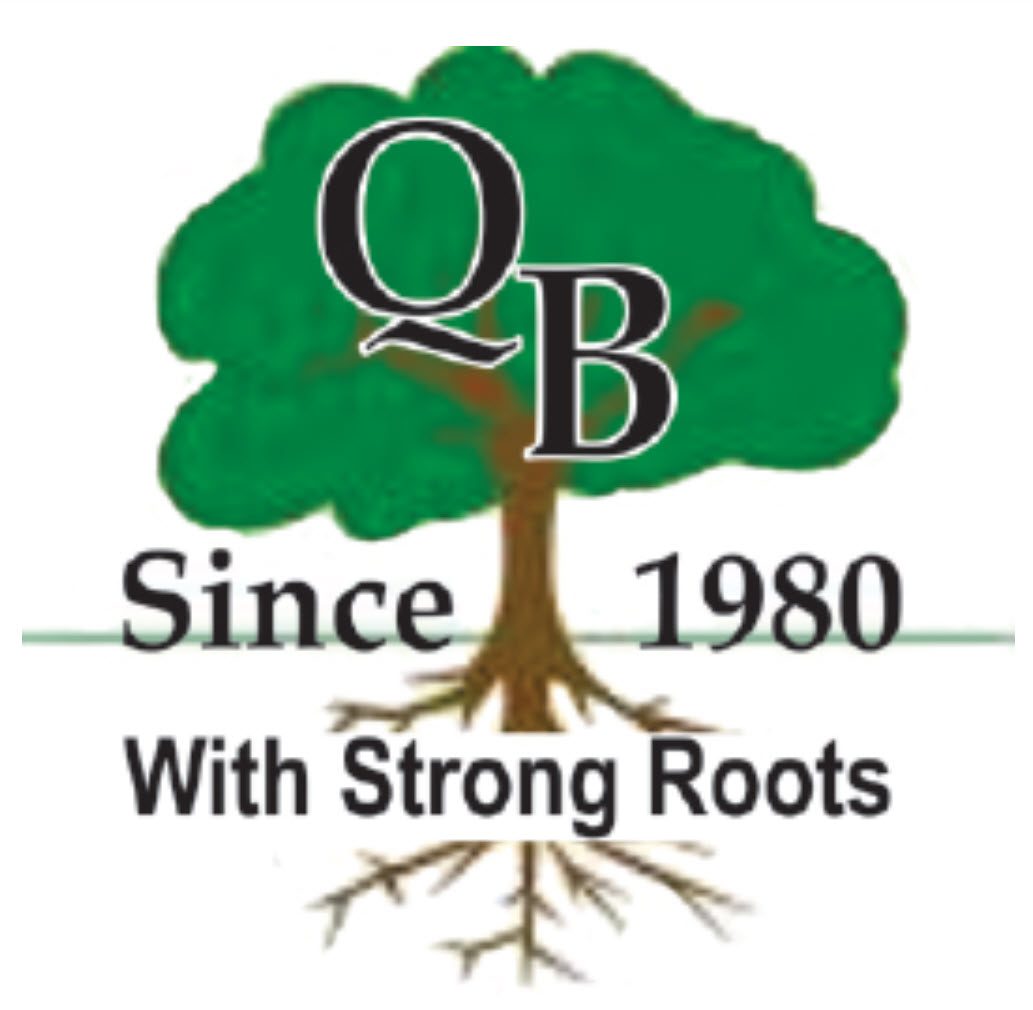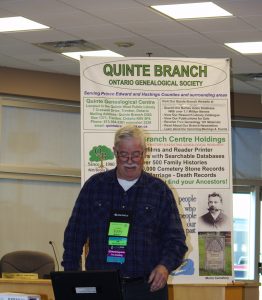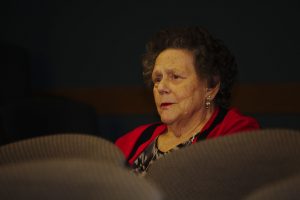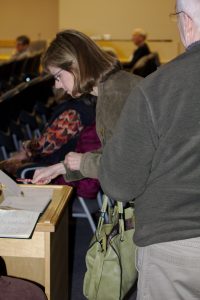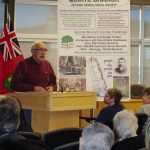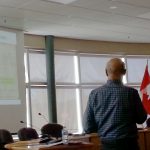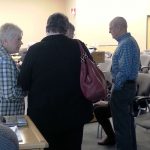Quinte Branch News
“Through the Years”
2021 | 2020 | 2019 | 2018 | 2017 | 2016 | 2015 | 2014
2012-2013 | 2011-2012 | 2010-2011 | 2009-2010
2008-2009 | 2007-2008 | 2006-2007 | 2005-2006
- Annual Quinte Branch OGS Christmas Party
- Annual General Meeting/Great Moments
- Shades of Allegiance: The Gerow Family
- The Humanity in the History
- Doors Open in Quinte West 2019
- Research the Ontario Archives from a Distance
- The Wonders of WikiTree
- Early Loyalist Roots of the Lower Hudson River Valley
- Organizing Your DNA Matches
- Family History “Reno Project”
- Irish Famine and the Settlement of East Hungerford
Annual Quinte Branch OGS Christmas Party
Photography by Adam Buttler
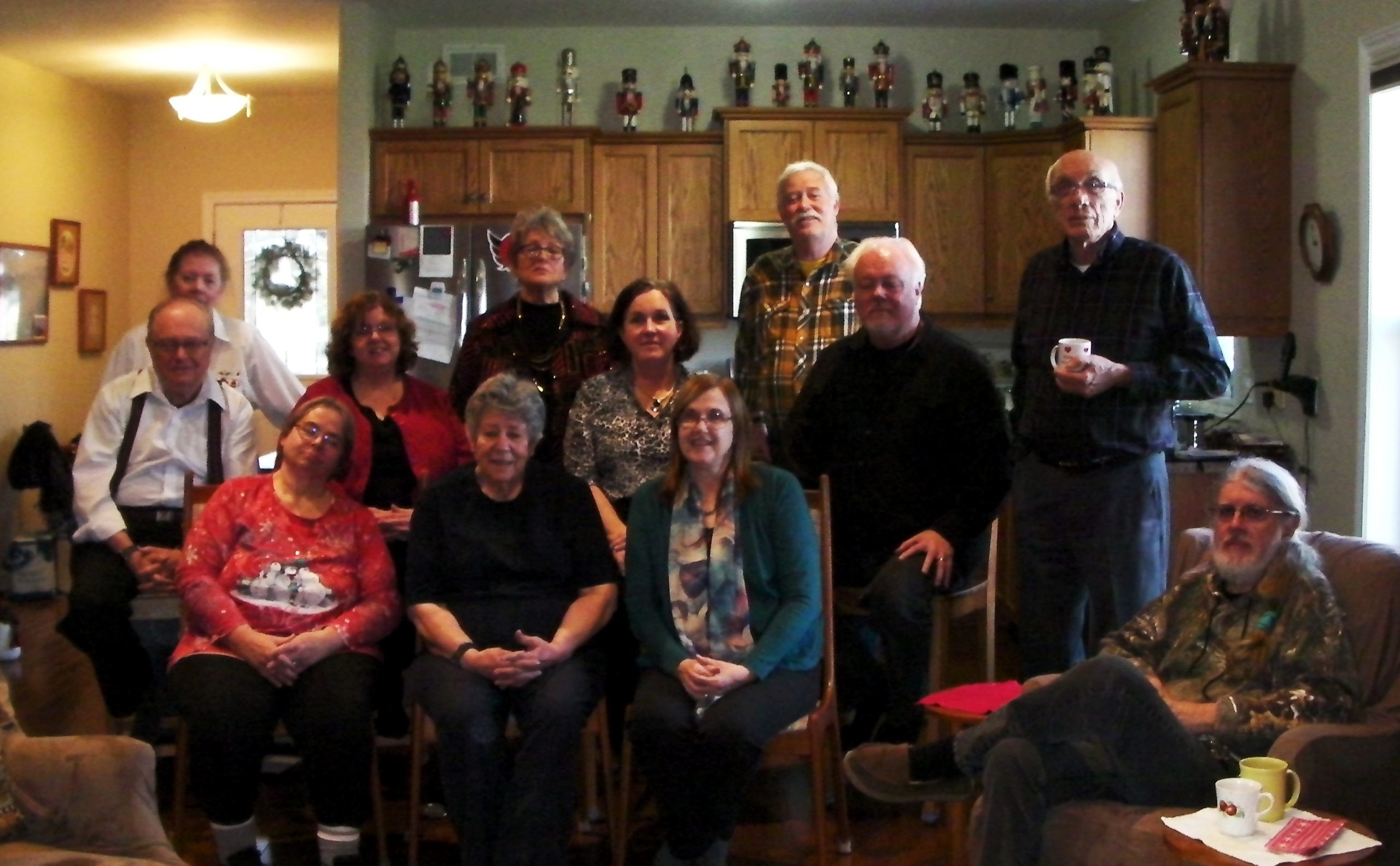
Sharron and Terry Buttler hosted a wonderful “end of year” party for the Quinte Branch Council members and their significant others at their home in Prince Edward County on Sunday, December 15. There was warm conversation and a heartfelt sharing of personal anecdotes. Lots of snacks and “finger foods” were available, topped off by the best chocolate dessert I have ever tasted (check with Cheryl for recipe). All of us left with a renewed sense of commitment and a positive anticipation of the Quinte Branch 40th “anniversary year” in 2020. Best of the festive season to all!
Annual General Meeting/Great Moments
AGM Chaired by Cheryl Levy
Election of Officers by Sharron Buttler
Article by John Carew
Photography by Wayne Wickson
To start off the afternoon, our 2019 AGM was chaired by Cheryl Levy, and focused primarily on the election of executive officers and the appointment of volunteers to Branch Council Committees. The parliamentary elections were led by Sharron Buttler. Following, we shared some new episodes of Great Moments in the search for truth in family history: good, bad and mostly inspirational. Council members provided the impetus for revelation and discussion and the assembly added their comments of agreement and/or alternate experiences. Lively at times, the session ended at library closing, just in time for a winter break and preparations for the events and activities planned for 2020!
The new slate of the Quinte Branch Council for 2020 will be published separately, in the Searchlight, and on our website. Snippets of the Great Moments adventures follow.
Two above mentioned narrations of research activity were shared with the attendees, and one of research library management. First, Cheryl explained that her ancestral history centered mostly in the Maritimes where she hails from, and that in her 40 years of family history research, she had always wanted to prove her early history in Nova Scotia. Some of that history came from the aftermath of the American Revolutionary War and Loyalist removal to Nova Scotia, and the balance came directly from the British Isles. What troubled her was the apparent lack of her ancestral records for the 1700s and early 1800s, much like many of us in Ontario whose Loyalist ancestors settled here. Over time and through perseverance, Cheryl eventually came to realize that there were many more genealogy and local history centers in the Maritimes than she had originally thought, and particularly, more old cemeteries. With the semi-proven facts which she already possessed, and new material from searching through several “new to her” local repositories and churches with cemeteries, Cheryl arrived at the moment of truth when she found Mary in a graveyard, a key heroin in her pedigree. Important for this purpose, when browsing through small cemeteries, look at all the headstones, not just the one you are looking for. They are all or mostly related. Otherwise you might not find Mary. The 1700/1800s were rife with blended families, the result of unexpected deaths from war, migration, illness and hardship. Like many others in the day, Mary walked up the isle to the alter 4 times in her lifetime. Name changes aside, the local records, cemetery headstone inscriptions and transcripts were sufficient to sort it out. It was a matter of following the clues, talking to the right people, and not being swayed by the false belief that Ancestry and Family Search has everything you might be looking for.
In her own excited voice, Cheryl leaned into the podium, looked straight at us and said “it was Mary! I found Mary.” She found many others the same way, but Mary was special. After all, it was Mary.
Second, Terry offered some thoughts on the newest research “phenomenon” in town, and the one that we are all, very much, day by day, learning to live with, DNA Testing. By all appearances, after several years, thousands of people are joining the ranks of “DNA Tested” every week, and the industry is catching up in the matter of how to use this significant set of research tools, which is much more scientific in nature and purpose than most of us are accustomed to. I was not an early adopter; I didn’t think I needed or wanted DNA as a crutch to get me across the family tree finish line. O well, I have been wrong before. Terry was not hesitant and I eventually followed his lead and the lead of others, from a safe distance. Progress and successful research are always the goals of family historians. To the extent possible, I have been more than happy seeing biological proof of cousins I have identified by other more conventional means. Also is the fact that, like it or not, in the universe of cousin material, we don’t get to chose who shows up in our match list, or why. For some, this is just an opportunity to get an unbiased opinion on one’s ethnicity and geographical history. No genealogical effort is intended or offered. The rest of the match list is predominantly hundreds or thousands of family historians looking for a magic connection to George Washington or the British Royal Family, or if possible, to supplement their traditional research methodologies.
Last November, in the Great Moments session, several of us shared the idea that adoptees and adoptive families searching to clarify birth family connections might well see DNA testing as a step forward in that pursuit, and a confidence builder that finding the correct birth family would be more likely. So, this year, after yet another year of DNA research methodology learning, Terry was mindful of the fact that not every child adopted out is aware of their particular family circumstances before the adoption, nor is it always the case that siblings in a birth family of an adoptee are necessarily aware that someone or some of the members of the family group are not accounted for. Thanks to Terry for this reminder.
In this regard, I am able to confirm that both of my adopted sisters (AKA sisters) were able to find their birth mothers’ families, and have to varying degrees been able to enjoy a partial relationship with birth family members.
Marilyn Harry, Heather Semper and Suzanne Mainprize, amongst others also added comments to the foregoing presentations and their own special moments in search of a complete family history. Some would say, “no such thing”: ok, but you can’t fault us for trying!
To complete the session, there was some discussion on the matters of copyright, copying or photographing or scanning of library research resources. Over the past year we have also been trying to identify a process by which we can shrink-wrap our holdings to conserve our valuable shelf space and preserve such materials for posterity. In addition to having a plan for the documents in our possession, there is also the matter of new donations and acquisitions. Emphasis on genealogies is most helpful in this regard. We can scan to preserve in PDF or other document formats, or we can encourage genealogy donors to donate digital files to Quinte Branch instead of or in addition to the tradition hard copy versions. We are looking at several ways to skin this cat, in the hope that the cat won’t be disadvantaged. As far as the copying or replication of documents by researchers is concerned, we are trying to achieve a balancing act of facilitating research and the effective use of our Quinte Branch library for that purpose, as well as being fair and respectful to the donors to our library for their generosity, their efforts to faithfully capture their true and factual history. When we figure out a sensible policy and plan for going forward respecting copyright and the joy of hardcopy and digital research, we’ll let you know. Hopefully, during 2020, our 40th Anniversary.
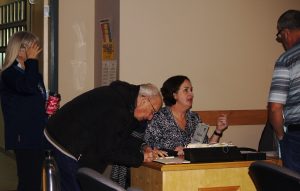 |
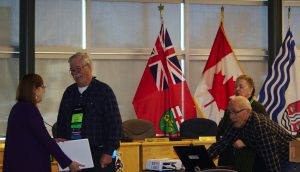 |
| Heather Semper Assisting with Registration | Cheryl, Terry, Sharron and John Planning |
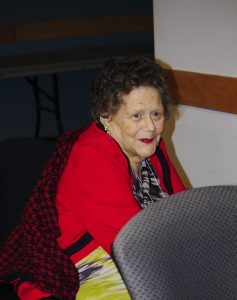 |
| Marilyn Harry: Charter Member and Active Volunteer |
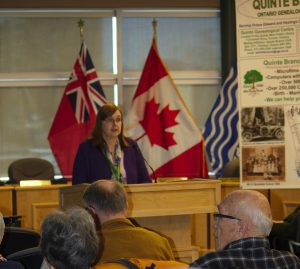 |
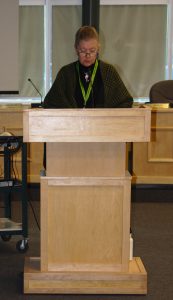 |
| Cheryl Levy Calling Meeting to Order | Sharron Buttler Chairs Election of Executive |
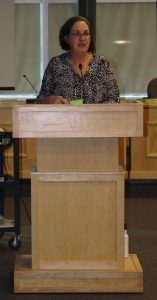 |
| Heather Semper Reporting Increased Membership |
Great Moments
A chance to share highlights of genealogical research during the past year!
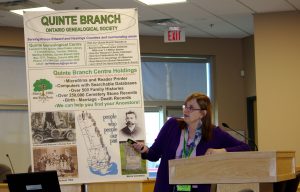 |
| Cheryl: Research in a Graveyard Can Pay Off |
|
|
| Terry: DNA Research Can Bring Big Surprises |
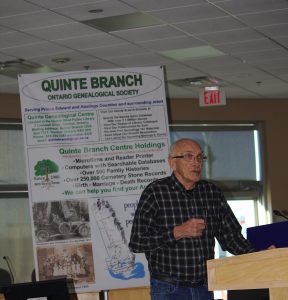 |
| John: Digital Record Keeping is the Way of the Future |
|
|
| Marilyn: Networking with Other Family Historians is Rewarding |
Other attendees shared successes and anecdotes drawn from their own genealogical research.
Quinte Branch Executive: 2020
Past Chair – Terry Buttler
Chair – Angela Johnson
Vice-Chair – John Carew
Secretary – Debbie McDonald
Treasurer – Patrick Goodmurphy
!! Kudos to Tina Gemmell (15 years) and Terry Buttler (5 years) for Service Awards !!
Shades of Allegiance: The Gerow Family
Presentation by Jane Simpson
Article by John Carew
Photography by Wayne Wickson
The Gerow Family from France fled from religious persecution as Huguenots to New York City at the dawn of the 18th Century. The family flourished until seeds of discourse infected the populace. Three sons of the family were forced to choose their allegiance to the English or to a seductive new republicanism. For one son, this includes throwing his lot in with a small colony of disaffected Americans to answer the call for settlers to the British Loyal Provinces. Members of the Alyea, Bogart, Bonter, Cole, Lent, Huff, Parliament, Peck, Roblin, Van Cott, Way, Wannamaker, and Westerfeld families, in addition to the Gerow family, chose to attend as their ancestors experienced the same fate during and after the Revolution.
The phrase “shades of allegiance” aptly portends the difficulties of choosing wisely, and secretively in many cases, and the anguish of choosing contrary to ones neighbours, and even in conflict with close relatives.
The telling of this story revolves around the Gerow brothers, Daniel Isaac and Benjamin. For Gerow, Alyea, Wannamaker and other allied families mentioned in the lead paragraph, this amounted to just less than 100 years in New York leading to the American Revolution when it became obvious that they would have to choose, one way or another, one of two very polarizing paths to the future.
As we already know, they opted for allegiance to the British. During the later decades of the 1700s, and early in the 1800s, the Gerow and several other families headed north, to several destinations, intermediate and otherwise, and our ancestors came to Prince Edward County and Hastings County. The abuse they suffered for leaving, physical and psychologically, was hard to accept and a lasting memory of disadvantage and discredit for the brand of loyalty that made sense to them. We thank them for their decisions, their journey, and their contribution to our community.
Our audience for the afternoon included Quinte Branch members, UELAC members and Gerow and allied families’ descendants in good number. After all, this was the opportunity for about 20 family historians of the subject families to share and validate their genealogy efforts, and to hear the facts from a cousin and well qualified raconteur.
Jane will likely be back for a return engagement.
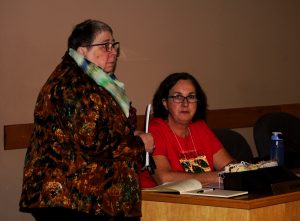 |
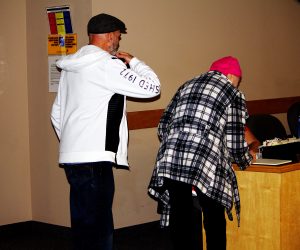 |
 |
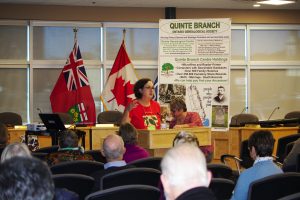 |
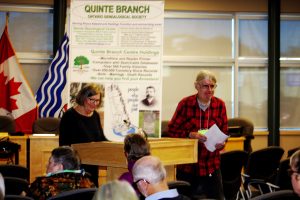 |
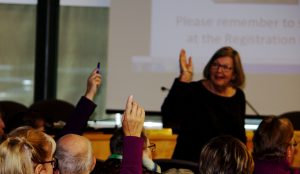 |
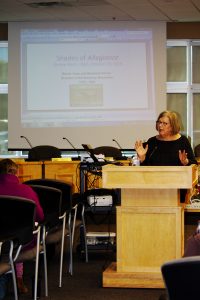 |
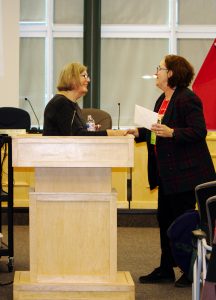 |
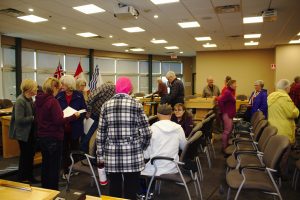 |
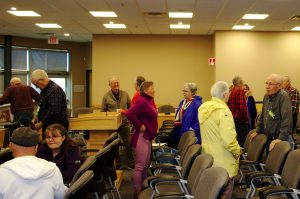 |
MEMBERSHIPS FOR 2020 OPEN ON NOVEMBER 1
CLICK HERE FOR 50% “Grow Our Family” DISCOUNT
Subscribe to Ontario Ancestors “eWeekly Update” [OR] View Previous Editions in the Archive
The Humanity in the History
Presentation by Jennifer DeBruin
Article by John Carew
Photography by Wayne Wickson
As mentioned in her background biography, 16 years ago, Jennifer began to do genealogy as a way to explore her own family history. Though many ancestors have been added to her extensive family trees in that time, it’s her understanding and position that it is the human story of each of these individuals that holds the key to unlocking their legacy. Not only coming to better understand our complex North American story, Jennifer has also developed a better understanding of who she is, and her place in the ongoing story. “As though listening to stories that echo through the generations,” discover how Jennifer uses her research and writing to journey with her ancestors in an effort to “discover the humanity in the history.”
In the span of an hour plus, Jennifer unraveled for us her multi European, Indigenous North American, American and Canadian ethnicities, the geographical migrations from Europe to the 13 Colonies, British North America and New France, the transitional and aspirational political and identity issues and decisions made by her ancestors pre and post American Revolution, and the relationships she discovered with her ancestors and their descendants above and below the 49th parallel. To the matter of the lecture title, at least one underlying takeaway message was research discipline which could unveil and describe their humanity, or, what made them relatable in the timeframes and lifestyle issues of their days. This not only made her family tree narratives about her ancestors more personal than just statistical, but enabling as well. Jennifer has successfully authored three books, featuring heroines and other significant ladies in her pedigree and the next two books will likely follow the same path. This kind of writing and documentation is only possible when the depth of research goes well beyond the statistics into the “what made them tick” arena. It seems that Jennifer has done that exceedingly well!
Following the lecture and the Q&A, Jennifer stayed to talk to the attendees for well over an hour, before she and her family headed home to the Smith Falls area. It was a great afternoon, and we all went home with another approach to keep in mind in our continuing family history research, balancing the humanity of our ancestors with their bricks and mortar history wherever possible.
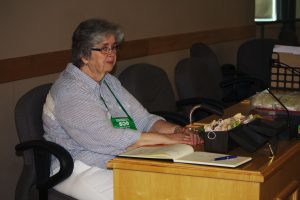
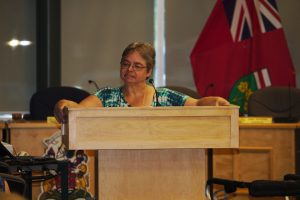
Angela J. sharing announcements and opening the meeting
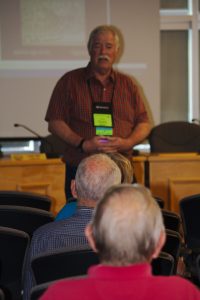 |
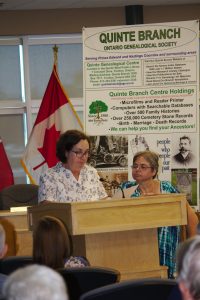 |
| Terry B. reporting on “Doors Open” | Heather S. reporting increased membership |
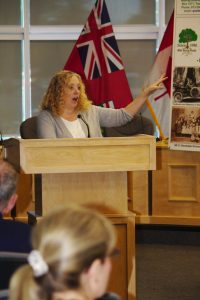 |
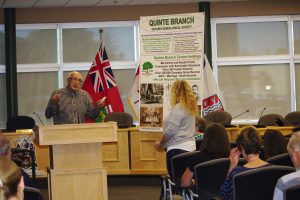 |
| Jennifer D. providing an animated talk | John C. thanking Jennifer |
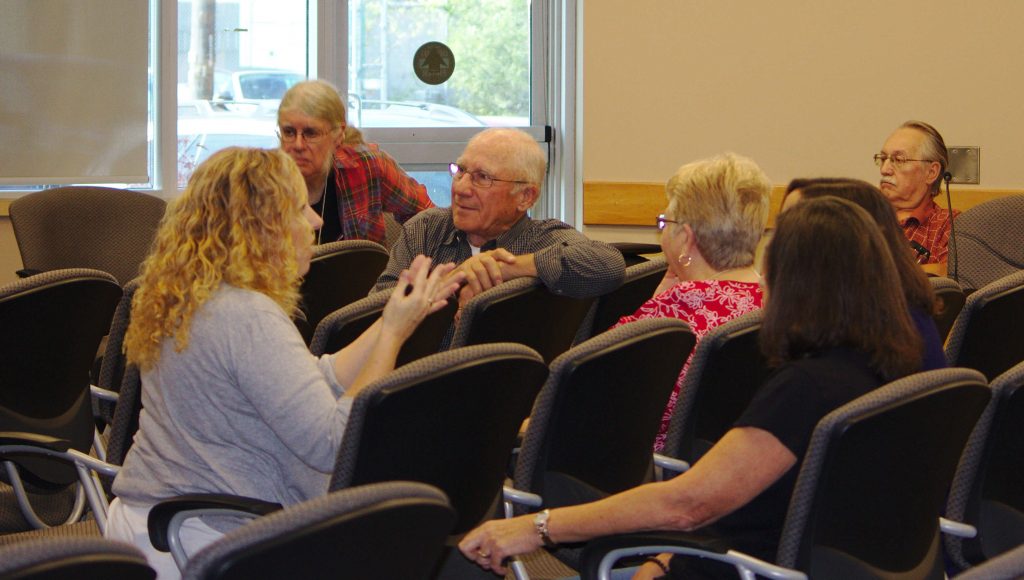
CHECK OUT JENNIFER’S WEBSITE AND HISTORICAL NOVELS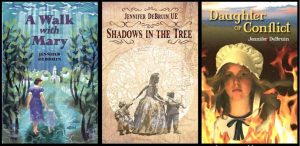
ALMOST TIME TO RENEW MEMBERSHIPS
CHECK OUT THE RESOURCES AT THE QUINTE BRANCH GENEALOGY LIBRARY
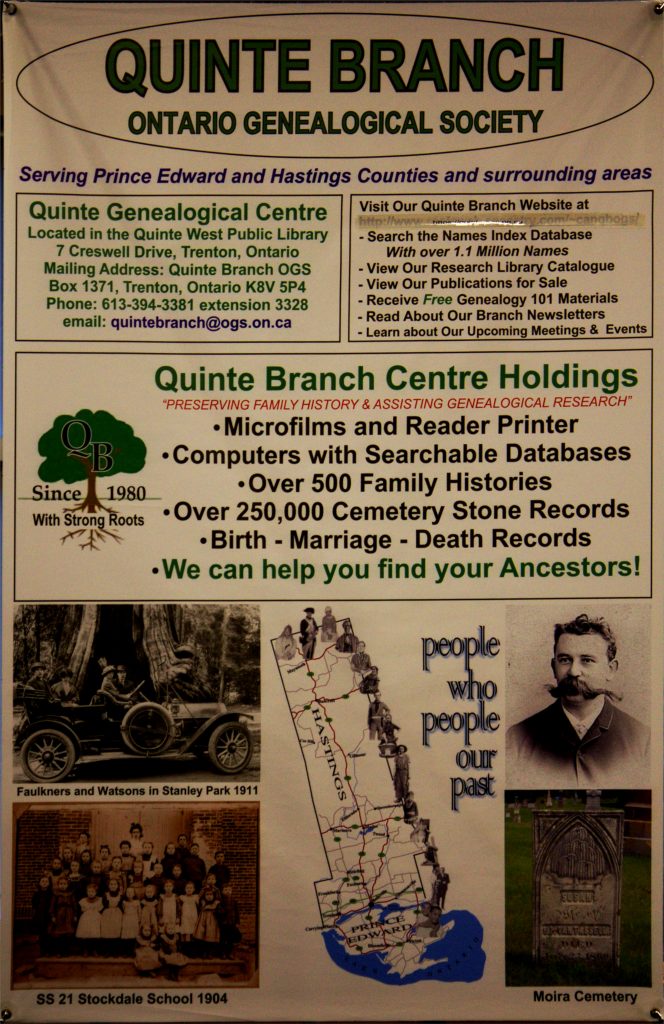
SOME OF THESE RESOURCES ARE AVAILABLE NOWHERE ELSE
Doors Open in Quinte West
Quinte Branch Genealogical Library
Photography by Wayne Wickson
The City of Quinte West is proud to be hosting its eighth annual “Doors Open” event on Saturday, September 14 from 10:00 am to 4:00 pm!
Quinte West is situated on the shores of the Bay of Quinte, located directly along the Highway 401 corridor, approximately 1.5 hours’ drive east of Toronto and 2.5 hours west of Ottawa. Formed in 1998 by the amalgamation of the former municipalities of Trenton, Sidney, Murray, and Frankford, the City of Quinte West offers its residents and visitors a unique and dynamic blend of rural and urban lifestyles. Quinte West’s natural setting, with its attractive scenic backdrop of rolling hills, rich farmland, clean waterways and rich history creates a healthy environment for working, living and visiting. The city’s special events and attractions – like some that you will experience with our Doors Open event – will make it obvious why we are “A Natural Attraction.”
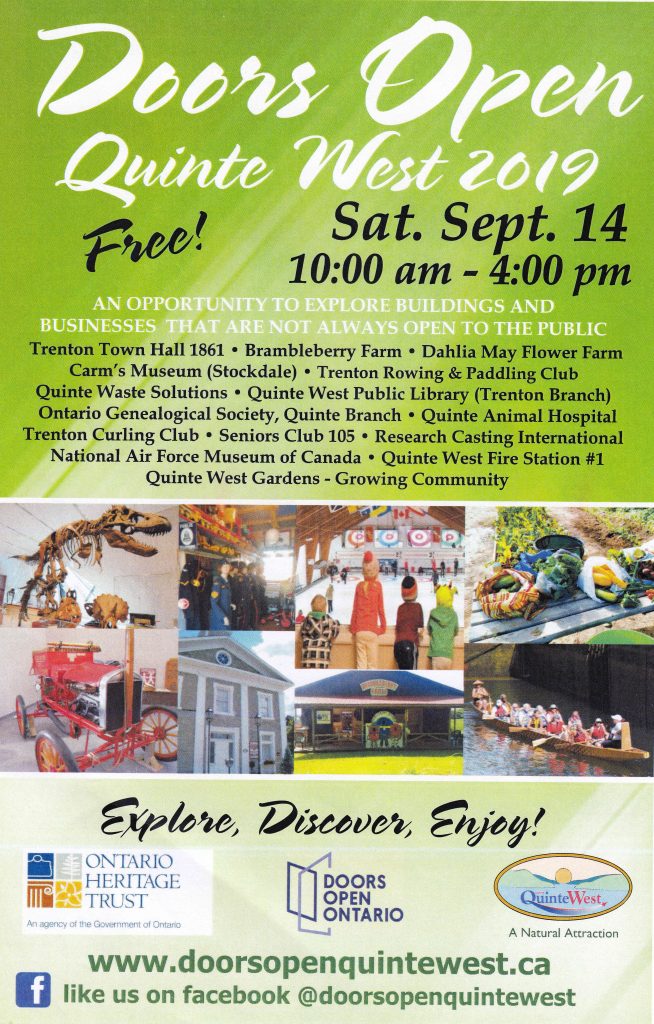
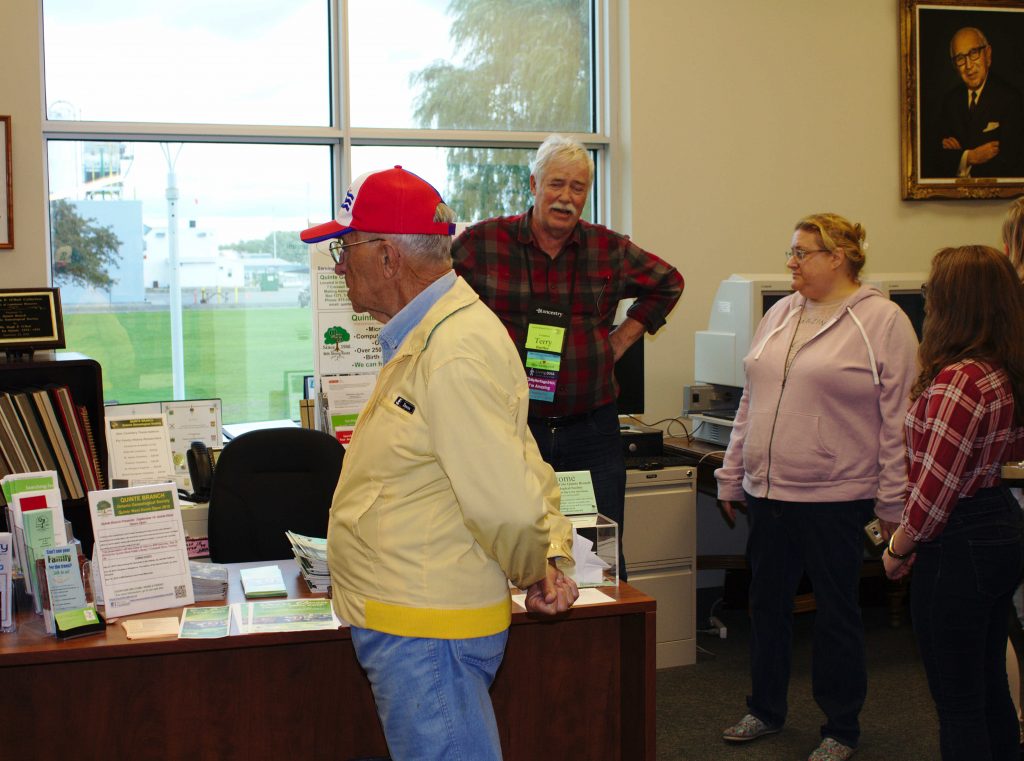
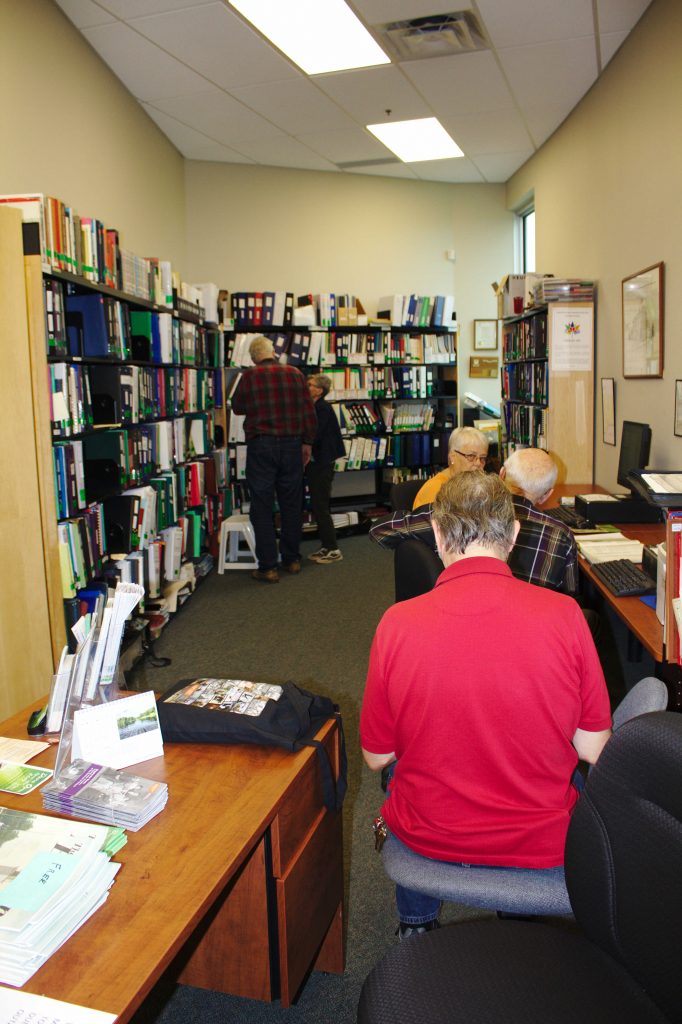
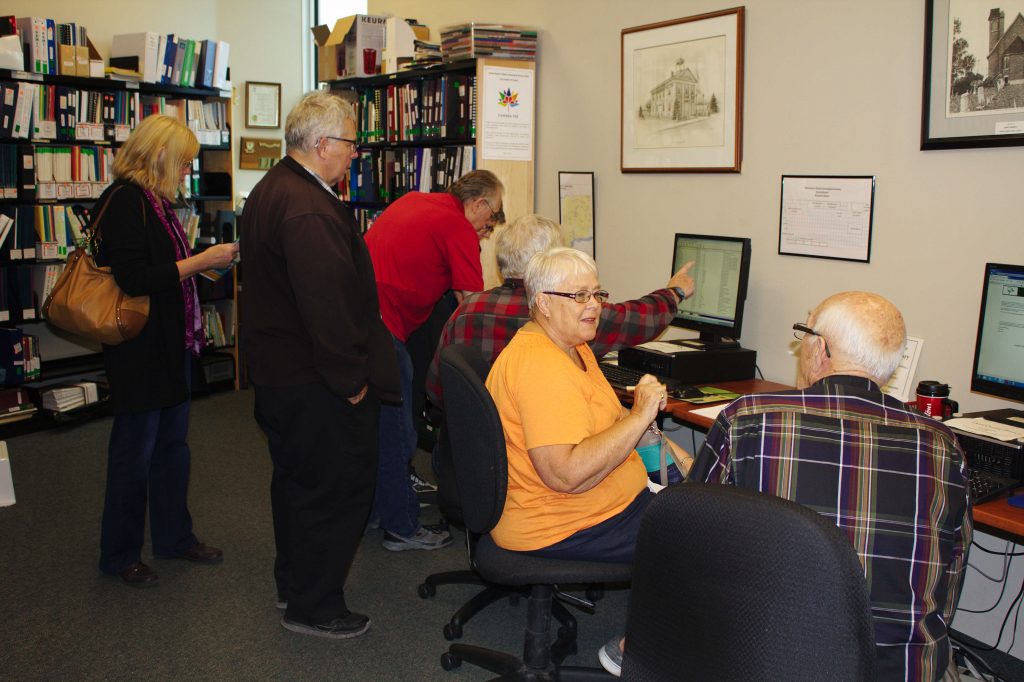
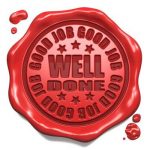
Terry B., Mary C., John C. and Patrick G. provided professional advice
to an active and inquiring stream of visitors to the
Quinte Branch Genealogical Library
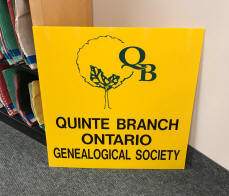 SEE YOU IN 2020!
SEE YOU IN 2020!
Research the Ontario Archives from a Distance
Presentation by Danielle Manning
Article by John Carew
Photography by Wayne Wickson
Quinte Branch Presents: Doing research from a distance, by Danielle Manning, Archives Ontario, https://www.ontario.ca/archives
This presentation was well-suited to researchers who are in the short-term less inclined to travel to Toronto to visit and research the Archives of Ontario in person, but who appreciate the choices of researching at home or away. Danielle went to considerable effort to show us how to use the Archives of Ontario’s website and Microfilm Inter Loan Program to access collections—particularly records that are helpful for genealogical research. In passing, she also explained which services are available from anywhere in Ontario and provided a guided tour of the Archives’ website.
Clearly, having the Outreach Officer for Archives Ontario present directly on the resources of our provincial archives and in particular, those resources directly and principally of interest to family historians was particularly useful for the 40 some attendees, for both onsite research opportunities in Toronto, and research from home through the use of their online genealogy services and records, including Vital Statistics (BMDs), Estate Files, and Land Records.
Obviously, our interests and focus were on Danielle’s very helpful comments on researching from home. Happily, she gave due recognition to other archives and databases including Library and Archives Canada, LDS Family History Centres, Ancestry and the broader online resources that we have come to appreciate for the variety and choices of information available through government and commercial repositories. When local resources such as libraries, OGS Branches, private genealogical societies, county archives and historical societies are added into the extensive choices we have for research, it is easy to understand how well served we are is our chosen pastime. And, not to ignore the benefits of our Provincial Archives less than two hours away, and all of its online resources accessible with one mouse click. Check out the website and research your heart out!
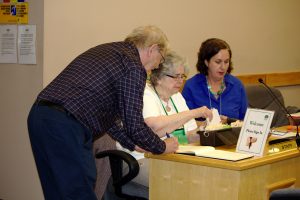
Attendees sign the “Guest Book” |
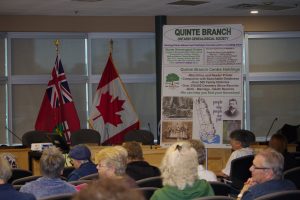
Audience discussion before meeting |
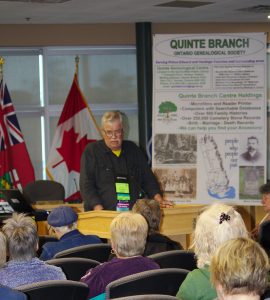
Terry Buttler welcomes eager attendees |
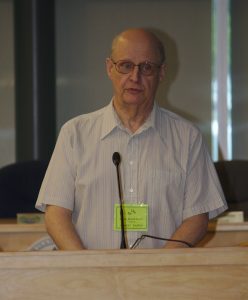
Bob Dawes introduces guest speaker |
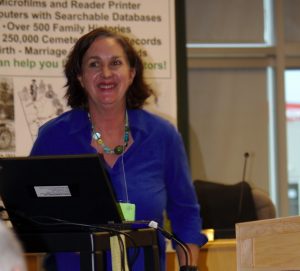
Heather Semper reports increased members |
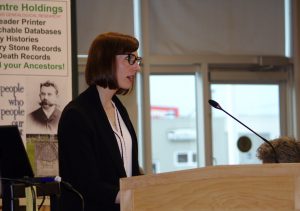 |
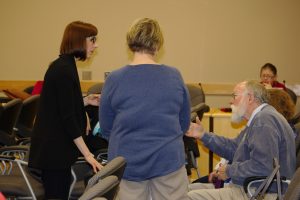 |
The Archives of Ontario maintains an active presence on “social media”.
The Wonders of WikiTree
Presentation by Leanne Cooper
Article by John Carew
Photography by Wayne Wickson
WikiTree (www.wikitree.com) is a free online collaborative family tree. In this presentation, Leanne Cooper provided an overview of WikiTree and its key features, and explored the various ways that WikiTree supports finding and collaborating with distant cousins and other genealogists. By working together, participating family historians can build more complete and accurate life stories of our ancestors and ensure that this information is accessible to all, only limited by privacy protection conventions which we are all generally familiar with.
During the week leading up to the presentation, I spent a few hours on the WikiTree website, to read into the subject, and to get a basic understanding of the WikiTree concept. Eventually, I would want to decide if I would want to participate or not. Leanne’s presentation was very helpful in filling in a number of gaps in my take on WikiTree and by the end of the day I was contemplating joining the program. The issues to understand and accept before charging ahead is that WikiTree is not just a place to park your tree outside of Ancestry or other host sites. Your tree, my tree, and everyone else’s tree on WikiTree is absorbed into one tree. The profile page for a person in “your” tree is shared by all who include that person in “their” trees, hence the term collaborative tree. Through a system of Profile management responsibilities, proven facts and sources pertinent to an individual are agreed to and improved on as necessary over time.
There were two cautions emphasized which bear repeating: respect the learning curve and don’t try to upload hundreds of people into WikiTree in one swift stroke. Eventually, once you have a handle on the system and the procedures, you can try more efficient means of populating WikiTree with your people. As well, it was suggested that rather than loading your whole tree into WikiTree as an immediate objective, use smaller GEDcoms to populate with your personal pedigree first, and expand as needed. May I also add my own two cents worth. Spend some time reading into the WikiTree concept on their website before you join the tree. The website is open to all and very user friendly with information.
I am curious enough at this point to try WikiTree. Good luck to all those who made a similar decision. See you on WikiTree!
Leanne Cooper is a federal public servant based in Ottawa. She spent most of her career at the Canadian International Development Agency and Global Affairs Canada and now works at Parks Canada. Her roots are primarily in New Brunswick and Prince Edward Island, with English (and a few Scottish) ancestors. She is an active member of the British Isles Family History Society of Greater Ottawa (BIFHSGO) and blogs at leannecoopergenealogy.ca. We enjoyed her presentation and question and answer period.
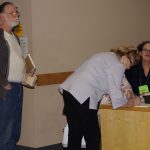 |
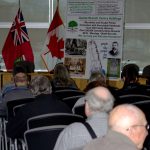 |
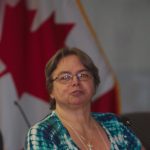 |
|
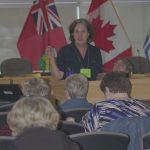 |
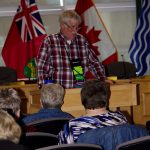 |
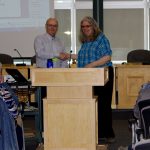 |
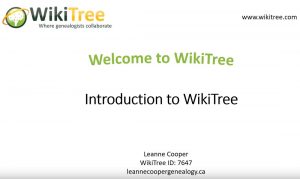 Check out the series of WikiTree videos on YouTube narrated by Leanne Cooper Check out the series of WikiTree videos on YouTube narrated by Leanne Cooper |
Early Loyalist Roots of the Lower Hudson River Valley
Presentation by Brian Laurie-Beaumont
Article by John Carew
Photography by Wayne Wickson
Brian Laurie-Beaumont had a forty-year career in heritage facility development planning across Canada. The focus on heritage preservation and his formal education as an historian made genealogy a natural outlet for his inquisitive nature – and a fondness for challenging detective work.
He is a member of the New England Historic and Genealogical Society, the New York Genealogical and Biographical Society, the Ontario Genealogical Society, and the British Isles Family History Society of Greater Ottawa.
Brian’s Beaumont family were settlers of Durham County, Ontario in the late 1850’s, coming from Yorkshire to farm. However, his wife Deirdre Hollis Laurie has very deep Loyalist roots in New England and New York, her maternal line (Hollis/Hambly of Napanee) being among the first settlers of Lennox and Addington County: Huffman, Parke, Garrison, and Salisbury, among others.
Previously, Brian gave a presentation at the Great Canadian Genealogical Conference in Halifax on his wife’s New England Planter and Loyalist roots in Nova Scotia which took in her ancestry from Massachusetts, Connecticut and Rhode Island. This time he will focus on her Ontario Loyalist ancestors from the lower Hudson Valley and New York City.
The presentation included sources for records, confusion between Dutch and English names, intersecting history and genealogy, historical sites remaining from the pre-revolution period connected to our Loyalist ancestors where one can walk where they walked.
The foregoing background on Brian’s career and his and Dee’s rich family heritage is well put to use in setting the table for what was a complicated story of the Loyalist Roots which straddled several ethnicities and several individual ancestors who made the gut-wrenching judgements to be Loyalists and come to Canada following the Revolutionary War. Unlike many of us with similar heritage origins which sprung from the colonial period in the north eastern states, the research required to properly and correctly identify the pioneer soup of Dutch, German, Huguenot and English forebears from the 1700s in New England and New York. To make up for the copious examples of lost and destroyed genealogy, business religious records from the period leading up to the UE exodus in 1783 and following, Brian has done what “needs must” in using with effect every credible genealogical, historical, archive and museum which caught his attention and could offer and shed light on the path of discovery. In his own view and words, the costs were comparable to the success achieved. Ouch! In addition, Brian has made full use of the many online databases (Ancestry and Friends), and the latest set of tools, DNA, and its various features, to drill down below the layers of clutter and the fog of war to the facts.
Brian’s presentation which ran for about 90 minutes was a masterful blend of focused North American Colonial history, family history research, a rendition of the plight of sources sought to do research and the tragic tales of their losses and misfortunes, the exodus from the “colonies” to the Maritimes, Quebec and Ontario, and the rightful acknowledgement of the family names that contributed to the achievements that we can consequently call part of our history, part of our story.
Brian and Dee, thank you for sharing your stories with us.
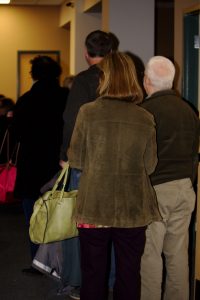 |
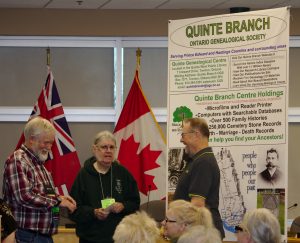 |
|
| Attendees line up to enter the workshop area | Terry Buttler, Past Chair, and Peter Johnson, Cemeteries Convenor, chat with Brian Laurie-Beaumont before the workshop | Attendees signing guestbook as they enter the workshop |
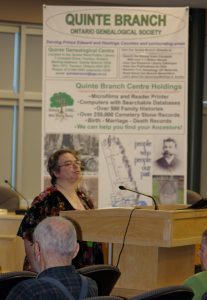 |
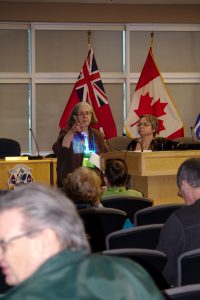 |
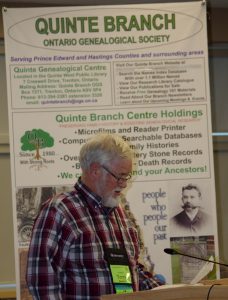 |
| Angela Johnson, Chair, welcoming attendees to the workshop | Lynn Heale, SIL Convenor, providing a membership update and explaining how the Surname Interest List can promote better research | Terry Buttler, Past Chair, introducing Brian Laurie-Beaumont to the meeting |
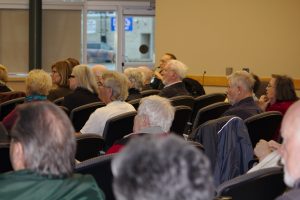 |
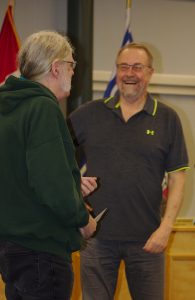 |
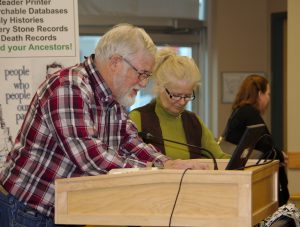 |
| Attendees listening to the slideshow presentation and preparing for question period. | Peter Johnson, Cemeteries Convenor, thanking Brian Laurie-Beaumont for an excellent presentation | Specific resources in the slideshow are eagerly examined after the presentation |
Organizing Your DNA Matches
Webinar by Diahan Southard
Article by John Carew
Photography by Wayne Wickson
This digital presentation (webinar) by Diahan Southard examined various methods for keeping track of your DNA matches – especially your autosomal matches. The kind of information you will need to keep track of and why will be covered using Excel, Word, email folders and correspondence. Diahan worked before and after graduation for the Sorenson Molecular Genealogy Foundation. Growing up with the budding genetic genealogy industry lead her to her current position as Your DNA Guide, where she provides personalized, interactive experiences to assist individuals and families in interpreting their genetic results in the context of their genealogical information.
Diahan strongly suggests to limit the matches that you might want to keep track of to those in your list of best matches, where the match is as 4th cousins or better, and where you may have a shared ancestral location or surname or both. Accordingly, your DNA test results will likely indicate roughly how many 4th cousins or better that you have, this week. The more people gravitate towards having a DNA test done, there will be a greater likelihood of ending up with more close matches. For many of us, that could be several hundred. With that many, you will likely want to prioritize where there is a perceived need, and work towards a longer list as the need arises. As to the nature of the information you may eventually want to collect, Diahan suggests 3 levels of information, grouped in this fashion:
Level 1, Contact info, relationship to the match, Testing company and a correspondence record,
Level 2, Predicted genetic relationship, paternal or maternal side, ancestral locations, ancestral surnames, confirmed relationship and shared common ancestors,
Level 3, Shared chromosome locations, amount of shared DNA, genetic shared match group, ethnicity and other ancestral background info, and GEDmatch ID.
From the beginning, you will likely find it necessary to amend your list of topics to keep track of, adding and removing as required to match your appetite for detail and the need for clarity. In addition to starting a separate email account for genealogy, you will probably find that Excel and Word (or equivalents) will do fine for your Level 1 information. For Level 2, Diahan suggests applications such as Transpose, and/or Evernote. And, for Level 3, more advanced tools such as Genomemate, DNA Gedcom Client and Gedmatch are recommended.
If you are going to make a stab at this, the suggested software choices or others which you are aware of should be considered to provide you with a level of thoroughness that you are comfortable with.
To be fair to ourselves, we should recognize that the genealogy industry leaders and lecturers are way ahead of us. Genealogy and DNA testing, not to mention software tools and the levels of software integration are being developed and refined as we speak. Bite off enough of this to be useful if you are interested, and build your databases while you are also building your confidence!
Good luck. Good hunting.
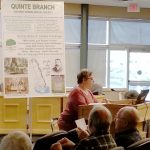 |
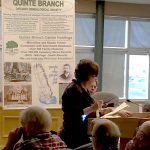 |
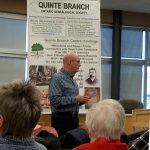 |
| Chair, Angela Johnson, opens the meeting and welcomes attendees | Heather Semper describes the current Quinte Branch membership | Bob Dawes answers questions regarding the webinar handout |
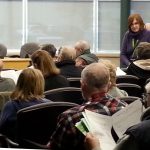 |
||
| Cheryl Levy engages with attendees before webinar |
Diahan Southard – www.yourDNAguide.com
Family History “Reno Project”
Presentation by Bob Dawes
Article by John Carew
Photography by Wayne Wickson
If you’ve ever wanted to clean up your family history file, this is the easy way to approach it. Normally, a Do Over (bottom-up approach) involves re-entering all of your family information from scratch while this Easy Reno approach allows you to continue using your file for research and enjoyment as well as cleaning it up. It allows you to take advantage of everything you’ve learned, over the years, as well as applying the benefits of new resources, records and tools. Bob Dawes is a past chair of Quinte Branch and is currently responsible for database and computer maintenance. Bob and his wife Barbara have traveled extensively in search of their ancestors and enjoy using technology to enhance their research.
Over the years, many of us have been faced with similar difficult choices (build a new house or renovate the kitchen and a couple of bathrooms). In this case of the family tree, abandoning 10- or 15-years’ worth of research would be a non-starter for me. But, the idea of embarking on a focused maintenance and update project where your tree and “blood, sweat and tears” are still relevant and each and every update you make in the “reno” is a bonus is certainly my choice for the creation of a new improved tree!
If you are looking for reasons for undertaking a file renovation, any of these provide enough justification:
1) Some of your early entries may not be complete.
2) New information/records have become available since you started (e.g. census).
3) Your research skills have improved.
4) New resources have emerged (e.g. DNA, online trees).
5) Your entry style lacked standardization (e.g. place names, sources).
6) You have unproven relationships in your tree.
7) You just want to clean things up. This is my favorite!
Most of us, no matter how experienced or how large or small the family tree, have done editing, adding a new fact or photo, correcting a typo or importing information from a new resource. All in all, that’s a reno. The only thing lacking is structure and focus. A sound approach suggested by Bob is to zero in on the 3rd great-grandparents’ generation and move forward from there, and back further if you wish and if there is a need to do so. By the time you finish this branch of your tree, on your schedule, you will have completed a major and important update to your tree, and you will be ready to tackle more, when time permits, and by then you will be armed with more skills and experience for these all-important reno tasks.
As a courtesy to you the reader, Bob has kindly agreed to make his presentation handout available.
Thanks, Bob!
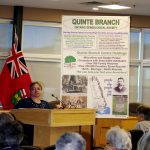 |
John Carew introduces presenter, Bob Dawes
|
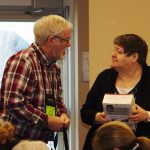 |
|
Bob discusses census record details
|
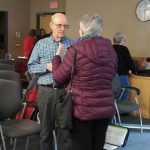
Bob engages with workshop participant one-on-one |
Bob listens to an in-depth discussion
|
“Irish Famine & the Settlement of East Hungerford”
Presentation by Jim Kennelly
Photography by Cheryl Levy and Peter Johnson
A near-capacity crowd of approximately one hundred interested enthusiasts listened with rapt attention as Jim Kennelly recounted the often grim history of the Irish peasantry under the threat of starvation and disease resulting from the Irish potato famine of the late 1840s and how this event propelled a million souls to relocate to North America hoping for a better life for themselves and their children. Many of the surnames that show up today in Hastings County and throughout Ontario can trace their family history back to this mass exodus out of Ireland. Spirited interaction with several members of the audience of Irish descent capped off the excellent slideshow and presentation. Jim was thanked by Terry Buttler who also drew the winning ticket and awarded a copy of the software package, FamilyTreeMaker, as a door prize to the lucky ticket holder. Quinte Branch Chair, Angela Johnson presented Carol Foshay with the Ontario Volunteer Award – her 15-year pin for her volunteer work with OGS.
Further research on the “Irish Potato Famine” and the Irish exodus it precipitated might include “Surplus People: From Wicklow to Canada” by Jim Rees or “Ontario and Quebec’s Irish Pioneers: Farmers, Labourers and Lumberjacks” by Lucille H. Campey or even “Irish Genealogy and Family History” at the Library and Archives Canada.
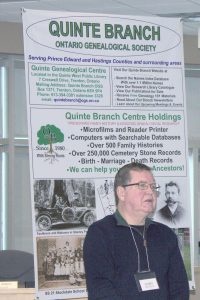
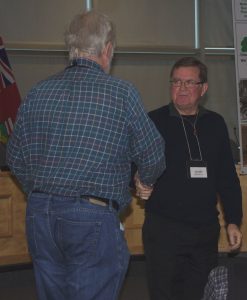
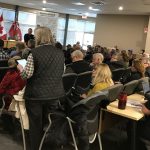
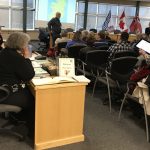
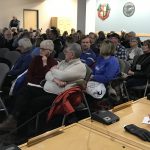
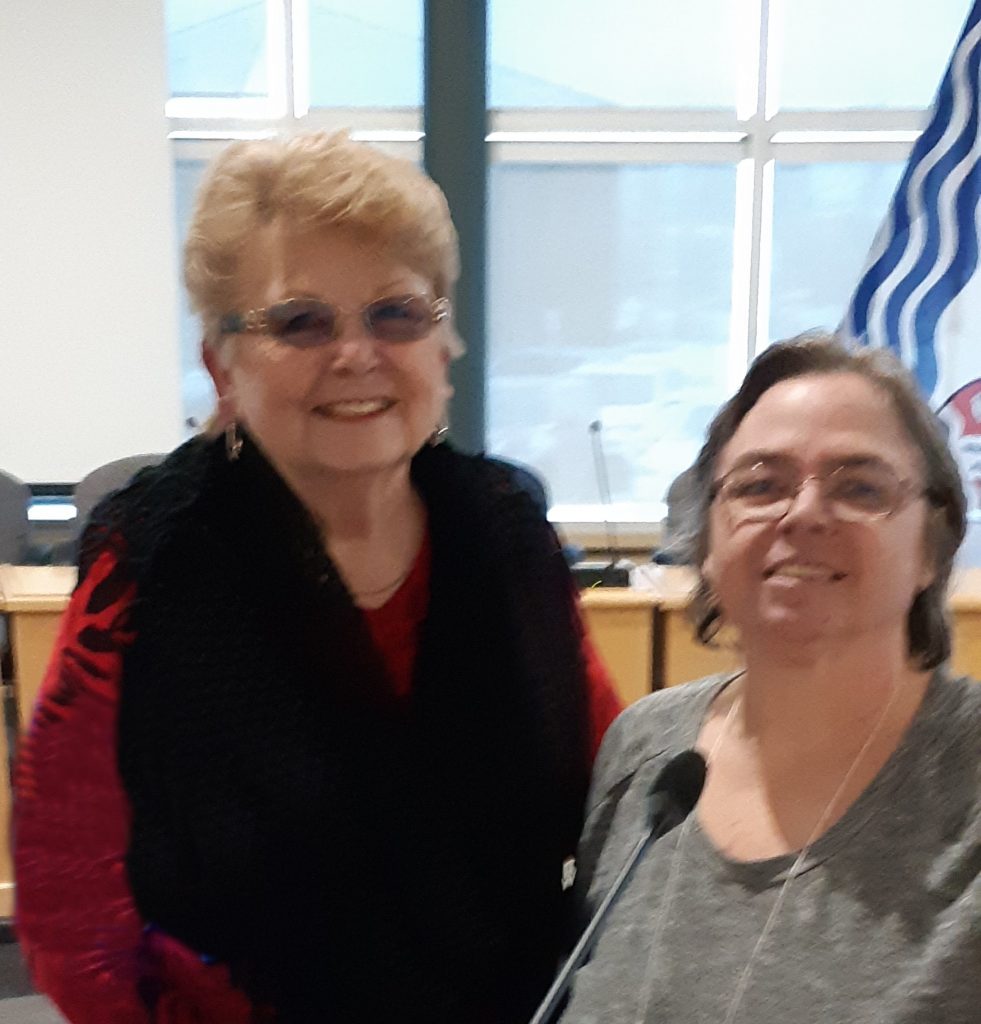
Carole Foshay receiving 15-Year Volunteer Award from Angela Johnson
